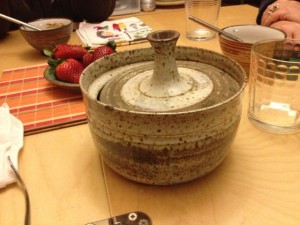Lingering at my sister Lisa’s dining room table this evening after dinner, my eye drifted to this casserole on a shelf opposite. My memories of childhood are vague, and I often depend on Lisa for the sort of specifics I can’t quite grab hold of. But neither of us could remember the casserole’s story, other than it had been in our family since forever, an object of extraordinary familiarity. Lisa reminded me that it traditionally held the Thanksgiving stuffing.
Given the world in which we grew up, chances were good that an object of this sort was made by someone we knew.
I flipped it over. Scratched on the bottom was the name “Whitey”.
The problem of hindsight in constructing the arc of one’s life story suggests that autobiography is as much fiction as fact. So bear in mind that much of this is likely bullshit, but indulge a middle-aged man trying to figure out how this all happened?
Whitey Watson (Lisa and I had to struggle to reclaim the last name, and I confess to breaking my personal rule against mobile phone googling at the dinner table) was a friend of my dad’s, part of a circle of artists in and around Claremont, California, in the 1950s and ’60s. Some of them had names big enough to end up in Wikipedia (Karl Benjamin, Sam Maloof, the local boy made good Millard Sheets). Mostly not. They pretty much all taught, at the Claremont Colleges or, like my dad, at one of the local community colleges. And they made stuff.
We were little kids, so among this group Whitey was the biggest star because she had this big ceramic mosaic mural at Disneyland’s Tomorrowland. Lisa reminded me this evening that you could see it really well from the PeopleMover. This was a big deal. I remember visiting Whitey’s studio as a very young boy and, at her encouragement, touching wet gray clay. I remember the round muddy grace of her wheel. I remember finding her signature at the bottom right corner of the Disneyland mural and touching that, too.
Recall that I’m making things up here, but I think I’m roughly on the right track when I place Whitey – Helen Richter Watson – somewhere along an important arc in ceramic arts, as this California crowd pushed against the functional craft tradition of plates and coffee mugs and the like and made art. Look at the magnificent gleaming ceramic pear forms – a still life in ceramics – featured in the permanent collection at Texas A&M’s Helen Richter Watson Gallery. No one’s going to be putting turkey stuffing in those.
And yet here we’ve got this magnificent little Whitey Watson casserole that has held the Fleck family’s food for half a century. It’s got a couple of chips because Whitey made it for us and we have used it.
When I was an intellectually ambitious young philosophy student, I tried to engage my father in a discussion about what art is. It was a disappointment, because he was profoundly inarticulate about the core issues. In later years, I made peace with my disappointment. He was a painter, not a word guy. He just did it, full of unarticulated assumptions, one piece at a time. (Mostly, that’s what we all do, myself included, word guy or not.) And learning what art was by watching him do it really was the thing, anyway. It took a while, but I think I’ve finally got a handle on it.
After college, I moved back to Claremont, fell in love with an artist (she’d made ceramics, no less!) and the romantic notion that I was going to be an artist too (whatever that meant), but with words. I worked at a small newspaper, to hone my craft, and bought myself a fine typewriter to write in the evenings. On our first date, I joined Lissa at an artist friend’s house in Padua Hills (Padua Hills!). Lissa had promised to cook her specialty, gyoza, in exchange for an old flat file the Padua Hills artist was getting rid of.
But my ambitions to art stumbled into the ceramicist’s dilemma. If you’re making a coffee mug, it can be magnificently beautiful, but it’s also gotta carry the coffee without leaking, and you’ve gotta be able to drink out of it. Whitey’s casserole is still in the family, and chipped, not only because of its great beauty, but because it works really well for turkey stuffing. I was writing newspaper stories, and they were most surely not art, but I was finding it enormously satisfying to sit at a typewriter and imagine what sort of coffee I wanted readers to get out of this mug I was making.
So that’s become my functional definition of what distinguishes craft from art – it’s gotta carry the coffee.


Excellent story. Thanks for sharing it with us.